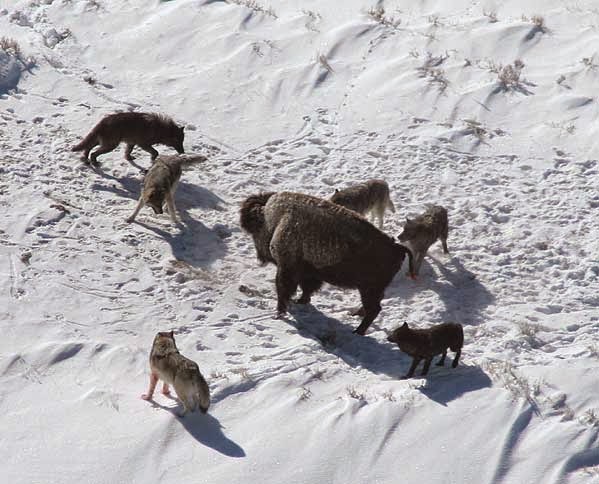Territory and Hunting Practices

Wolves will stay in their own territory so long as there is enough food. The core part of their territory that they spend half of their time in averaging about 35 km² (14 sq miles). When their pups start to grow, they are constantly on the move looking for more food, and will often widen their territory. As wolves are highly territorial, they will defend their territory if other packs try to come into the area and attack the other pack, if necessary. They mark their territory with urine and feces every couple hundred meters to let other wolves know the boundaries. They also use howling and ground scratching as a way of letting others know the territory is already taken.
 Their fine sense of scent is often used to locate prey, though they may also use tracking or react to chance encounters. When hunting, wolves will not sneak up on their prey, nor will they single out an animal until the herd begins running. This approach strategy is used only by cursorial predators and differs greatly from that of other large predators such as lions or cougars. Whether they are targeting a lone individual or a herd - getting as close as possible is very important, in order to shorten the chase. Then once the prey is aware of them, the prey is left with two choices: to run or stand their ground.
Their fine sense of scent is often used to locate prey, though they may also use tracking or react to chance encounters. When hunting, wolves will not sneak up on their prey, nor will they single out an animal until the herd begins running. This approach strategy is used only by cursorial predators and differs greatly from that of other large predators such as lions or cougars. Whether they are targeting a lone individual or a herd - getting as close as possible is very important, in order to shorten the chase. Then once the prey is aware of them, the prey is left with two choices: to run or stand their ground.  Larger animals, like elk and moose, usually stand their ground, and the wolves have little chance of bringing the animal down. But if the prey decides to run, the wolf pack follow in hot pursuit, eventually tiring the animal. Wolves will usually chase an animal for 1 to 2 km, but longer chases have been known. If the prey animal is part of a herd, the wolves will try to chase it away from the main body to isolate it and bring it down.
Larger animals, like elk and moose, usually stand their ground, and the wolves have little chance of bringing the animal down. But if the prey decides to run, the wolf pack follow in hot pursuit, eventually tiring the animal. Wolves will usually chase an animal for 1 to 2 km, but longer chases have been known. If the prey animal is part of a herd, the wolves will try to chase it away from the main body to isolate it and bring it down.http://www.pbs.org/wnet/nature/river-of-no-return-gray-wolf-fact-sheet/7659/
http://en.wikipedia.org/wiki/Gray_wolf
http://www.cc.gatech.edu/ai/robot-lab/hunt/wolfProject.html